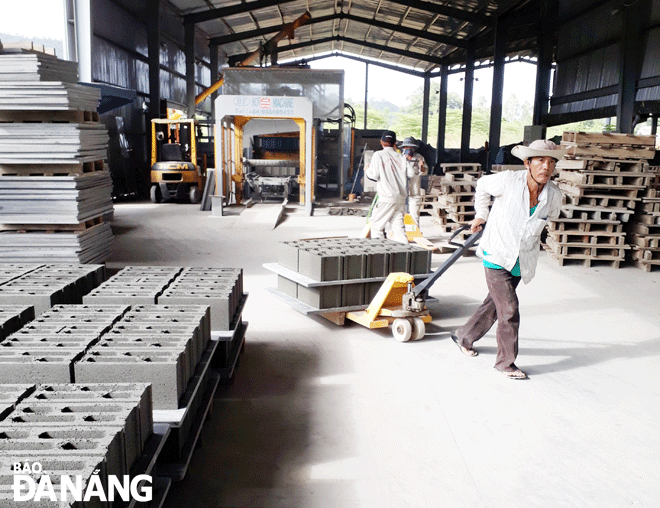Eco-friendly building materials revolutionise home construction
The Vietnamese Ministry of Construction has just directed the Viet Nam Association of Building Materials to encourage enterprises to continuously research and produce new and high-tech products in a bid to meet the needs of the urban housing and construction market towards green and sustainable development.
 |
| The production of unbaked bricks at the Secoin JSC, located at the Hoa Khanh Industrial Park. Photo: TRIEU TUNG |
Producing high-tech, environmentally friendly building materials
According to Mr. Pham Van Bac, Director of the Department of Building Materials under the Ministry of Construction, the country’s strategy for developing the building material industry during the 2021-2030 period, with a vision to 2050, identifies six consistent perspectives.
They are promoting the development of the building materials industry in an effective and sustainable manner to meet domestic demand and gradually increase exports; boosting the application of scientific and technological achievements; effectively using resources and thoroughly saving energy, raw materials and fuel; minimising the impact on the environment during the process of mineral mining and processing; encouraging all economic sectors to invest into and develop the building materials industry; and supplementing a nationwide network of building material production facilities suitable to the natural and social conditions of each region.
Mr. Pham Van Bac emphasised that, Viet Nam has made a development programme for unbaked construction materials to 2030 aims. The programme aims to promote the production and use of unbaked building materials to replace fired clay bricks, effectively use agricultural land resources, reduce greenhouse gas emissions and environmental pollution, and make use of waste from industries.
Currently, the building materials industry has produced a number of smart products such as insulating foam, eco-friendly roofing sheets, lightweight concrete bricks, fired clay panels, glazed tiles, green wall tiles, green cement, and recycled paving bricks.
Aside from researching to produce new eco-friendly building materials, such traditional building materials products as cement, bricks tiling, sanitary ware, steel, and glass also had a change in production technology in order to increase durability, save energy, save production and construction costs, especially adapting to climate at the construction site.
The need to protect the environment is the society’s top priority, so the design and architecture also develop in a sustainable way. In fact, many organisations and enterprises have applied science and technology in producing green, clean, recycled materials, and alternative materials have many advantages over traditional products.
Vice President cum General Secretary of the Viet Nam Concrete Association and Vice President of the Viet Nam Association for Building Materials Tran Ba Viet said that the trend of using super-performance concrete is a sustainable green material. Accordingly, super-performance concrete has been studied and applied relatively popularly in developed countries around the world. Viet Nam has had a number of practical applications such as building bridges with super-functional concrete beams, manufacturing architectural facades and others.
Positive transformation in Da Nang
In Da Nang, almost all government budget-funded projects in the city are involved in the use of unbaked bricks.
In addition to brick products, a number of high-tech building material products were also invested by enterprises and recorded positive signals from the market.
Typically, the production and business activities of the Da Nang Light Concrete Joint Stock Company have produced and supplied high-performance concrete self-inserting bricks with a variety of designs and colours with the E-Brick brand name.
The new product can be used in such construction works as sidewalks, parking lots, internal roads of residential areas, urban areas, gardens and parks.
Most recently, the city has seen a boom in green buildings that use new construction materials.
The approach to using environmentally friendly building materials comes from the needs of investors.
According to the Director of Alpes Green Design & Build Company, Architect Ho Khue, the initial installation costs of green products may be slightly higher than traditional materials. However, in the long run, such new technology products will save more energy, be more optimised, and have a longer use life, thereby saving money for users, and investors.
To promote the production and consumption of unbaked construction materials, thereby gradually reducing the production and consumption of baked clay bricks, the municipal Department of Construction has proposed the Ministry of Construction and relevant ministries and branches to soon promulgate specific standards on construction and acceptance for concrete bricks in order to improve construction quality and prevent wall cracking when using this material.
Reporting by TRIEU TUNG - Translating by M.DUNG








